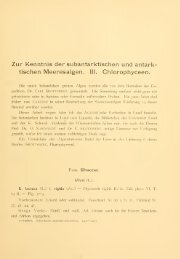Download PDF
Download PDF
Download PDF
You also want an ePaper? Increase the reach of your titles
YUMPU automatically turns print PDFs into web optimized ePapers that Google loves.
8o ZYGNEMATACEAE<br />
occupying only a part of the axis of mature cells. The nucleus is<br />
near the center of the cell, placed on one side of the chromatophore<br />
in those species which have a single chromatophore. In<br />
species with two chromatophores, such as M. protia, the nucleus<br />
lies in the bridge between the chromatophores. Under natural<br />
conditions favoring active growth the chromatophores of M.<br />
capticina may be either ribbonlike or rodlike, and the cells may<br />
have purple cell sap in some filaments instead of the usual color-<br />
less solution. The pyrenoids in most species are arranged in a<br />
linear row; in a few they are scattered throughout the broad plate-<br />
like chromatophores.<br />
Of the 99 species here described, 92 usually reproduce by means<br />
of zygospores, and 7 by aplanospores. Of the 92 zygosporic species,<br />
25 also occasionally produce aplanospores either in the same<br />
filament with zygospores, or in separate aplanosporic filaments.<br />
Scalariform conjugation occurs in 86 species. Conjugation<br />
may be either scalariform or lateral in 4 species, and in only 2 is<br />
it regularly lateral.<br />
Almost all the species are isogamous; only 3 species are strictly<br />
anisogamous, and 2 others somewhat variable even in the same<br />
paired filaments. The distinction between parthenospores and<br />
aplanospores is not always easy to make. In many of the 25 species<br />
reproducing both by zygospores and aplanospores, the form<br />
and placement of the spores are somewhat different. In those<br />
species having aplanosporic filaments the distinction is more<br />
evident. These filaments are quite regularly zigzag with the<br />
spores at the angles, the first facing in one direction and the next<br />
in another direction. Hassall described such filaments in 1842,<br />
and figured an immature one in 1845 {M. notab'iUs). Wittrock<br />
(1878) also discussed this feature of aplanosporic filaments when<br />
he proposed the genus Gonatonema. Paul Petit (1880), the Wests<br />
(1902), and Czurda (1931) have suggested that these spores may<br />
result from internal division of a vegetative cell followed by<br />
lateral conjugation. This speculation still awaits cytological evi-<br />
dence. In the hundreds of developing aplanospores studied by<br />
me and my associates, not a single example of preliminary division<br />
of either the protoplast or the nucleus has been found. There is<br />
good reason to believe that rare instances of lateral conjugation<br />
may be found among the usually scalariform species of Mougeotia<br />
just as in Zygnema and Spirogyra. Such instances, however, can-




